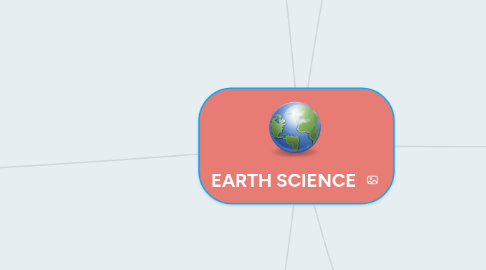
1. Atmosphere
1.1. composed of:
1.1.1. 78% Nitrogen
1.1.2. 21% Oxygen
1.1.3. 1% other gases
1.2. Layers:
1.2.1. Troposphere
1.2.1.1. lowest layer; decreasing temperature with increasing layer
1.2.1.2. weather systems are found here
1.2.1.3. air pollution accumulates here
1.2.1.4. absorbs infrared rays
1.2.2. Stratosphere
1.2.2.1. right above the troposphere
1.2.2.2. increasing temperature with increasing altitude
1.2.2.3. Ozone layer is here; traps most of the harmful UV rays
1.2.2.3.1. Electromagnetic radiation (EMR) is absorbed mostly in the Stratosphere
1.2.3. Mesosphere
1.2.3.1. third layer from the Earth's surface
1.2.3.2. decreasing temperature with increasing altitude
1.2.3.3. most of the objects from space burn up here
1.2.4. Thermosphere
1.2.4.1. gradiational layer into space
1.2.4.2. increasing temperature with increasing altitude
1.2.4.3. most harmful rays are absorbed here (i.e. X-rays, gamma rays)
1.3. WATER AND IT'S ROLE IN THE ATMOSPHERE:
1.3.1. water is the only natural compound that can exist in all three states (solid, liquid, and gas)
1.4. HUMIDITY
1.4.1. humidity is the moisture in the air
1.4.2. air is considered "saturated" if it contains water vapor and cannot hold any more
1.4.3. the higher the temperature, the higher the humidity due to the evaporation caused by the temperature (that's why hot and humid go together as opposed to cold and humid)
1.5. CLOUDS
1.5.1. clouds are formed by accumulated water droplets turned into cloud droplets
1.5.2. name connotations:
1.5.2.1. "cirr-" : high level and wispy
1.5.2.2. "alto-" : mid-level
1.5.2.3. "nimbo-" / "-nimbus" : associated with rain
1.5.3. PRECIPITATION:
1.5.3.1. COALESCENCE: when water droplets combine that become too heavy to stay aloft and precipitates as rain
1.5.3.2. ICE CRYSTAL PROCESS: when super cool water droplets and ice crystals combine that becomes too heavy to stay aloft and precipitates as snow or hail
2. ROCKS AND MINERALS
2.1. Rocks are composed of minerals
2.2. IGNEOUS ROCKS
2.2.1. VOLCANIC ROCKS: Rocks cooled from magma on Earth's surface; rapid cooling thus smaller crystals
2.2.2. PLUTONIC ROCKS: Rocks cooled from within the Earth's interior; slow cooling due to geothermal gradient thus large crystallizations
2.3. SEDIMENTARY ROCKS
2.3.1. Clastic rocks: Most common form of sedimentary rocks; form by generation, transportation, and lithification
2.3.2. Chemical rocks: Formed by chemical processes that could include precipitation
2.3.3. Biochemical rocks
2.4. METAMORPHIC ROCKS
2.4.1. Contact Rocks : Rocks that come in contact with heat source
2.4.2. Regional rocks: Rocks that come relatively close to heat source
3. PLATE TECTONICS
3.1. Convergent plate boundaries
3.1.1. When the converge or go to the same direction which leads to tectonic plates crashing into each other
3.2. Divergent plate boundaries
3.2.1. When tectonic plate boundaries go in opposing direction which causes it to move apart
3.3. Subduction zones
3.3.1. Area wherein one parchment of land goes underneath the other
3.4. Reverse-fault
3.4.1. When fault movement goes up
3.5. Normal-fault
3.5.1. When fault movement goes down
3.6. Strike-slip
3.6.1. When fault movement is side-to-side
4. Weathering
4.1. Physical Weathering
4.1.1. Unloading
4.1.1.1. when top layer of soil erodes thus underlying layer expands upwards creating pressure cracks (joints) which are considered weak zones and are parallel to the surface
4.1.2. Wedging
4.1.2.1. when water seeps through in between those pressure crack joints and due to the alternating above and below freezing temperature, the water expands thus creating larger gaps between soil particles
4.2. Chemical Weathering
4.2.1. Dissolution
4.2.1.1. when a rock or soil dissolves in water or carbonic acid
4.2.2. Hydrolysis
4.2.2.1. when hydrogen ions replace silicate materials
4.2.3. Oxidation
4.2.3.1. when a substance gets exposed to oxygen (i.e. rusting, yellowing or reddish color in rocks)
4.3. Biological Weathering
4.3.1. Microscopic
4.3.1.1. cannot be seen by the naked eye
4.3.1.2. usually caused by animal matter and decaying material
4.3.2. Macroscopic
4.3.2.1. can be seen by the naked eye
4.3.2.2. i.e roots
5. Soils
5.1. formation is controlled by:
5.1.1. climate
5.1.2. organic activity
5.1.3. water
5.1.4. etc???
5.2. LAYERS:
5.2.1. O horizon (organic material)
5.2.2. A horizon (topsoil)
5.2.3. E horizon (subsoil; zone of leaching)
5.2.4. B horizon (minerals from A horizon dropped here)
5.2.5. C horizon (bedrock)
5.3. rate of weathering affected by:
5.3.1. Rock Composition
5.3.2. Rock Type
5.3.3. Climate
5.3.4. Slope of landform
5.3.5. something else
